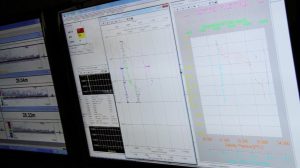23 June 2016
The Thrill of Predictability
Posted by larryohanlon
This is the latest in a series of dispatches from scientists and education officers aboard the Schmidt Ocean Institute’s R/V Falkor, currently on an expedition measuring nutrient fluxes to the South China Sea. Read more posts here, and track the Falkor’s progress here.
There are those who argue that predictability is the greatest gift of progress, the biggest merit of civilization. Our ability to explain nature through science makes the world and the universe predictable and understandable. That enables us to have a more informed and productive relationship with our natural environment and its resources.
This is at the heart of physical oceanographer Dr. Annalisa Bracco’s work. The first project she participated in as a graduate student proved how the planets are formed, a contribution for which she is still widely quoted today. After starting her career on such a high note, what could she follow with? She was born in Italy, surrounded by the Mediterranean Sea, so the decision came naturally for her: she was going to focus on the ocean.
Annalisa is a modeller, which means she creates mathematical scenarios in order to explain physical processes. She examines nature, interprets the physical reasons behind its operations, translates these into equations and formulas producing likely scenarios and results, and then waits for real-life observations that either support or dismiss what her models suggest.
Her work today deals with how ocean circulation transports and mixes microbial life and chemicals. With this understanding, she can then study how those physical processes affect our climate, biodiversity and evolution. One equation at a time, she turns the oceans into more predictable landscapes.
Computational Processing Power

Even a simple equation explaining mass evolution in oceanic waters seem very complex. Credit: SOI/Monika Naranjo Gonzalez
Annalisa uses an equation that deals with the evolution of mass in oceanic waters. She explains how the variables (velocity and space in its x and y axis) relate to each other and how the result – if the system is stable – should be equal to zero. If you don’t get zero, you start getting convergence. From there, things get very complicated, very quickly for the untrained listener. There is no reason to feel bad about not understanding, because even supercomputers can not deal with such complex calculations. There is no computer that can run them at a global scale (or even at the microscopic scale either).
Annalisa has no choice but to break the system into pieces. For instance, she knows that here convergence (when water with different densities merge, such as when fresh and salty water meet) occurs in radii of 1km and with depths of around 100 meters. Some 15 years ago scientists did not think such small scales could have a real impact in the ocean’s composition, but now we know they do. This explains the patchiness we have observed from R/V Falkor while crossing between the ocean’s water to the river’s plume. This also explains why the team has found very different planktonic communities in stations that are not so far apart.
Our understanding of these physical dynamics is still very limited. Yet, in order to decipher larger planetary workings such as Carbon sequestration by phytoplankton, we need to understand these patches better and extrapolate them into larger scales.
Riddle Me This
Several CTD casts show sudden changes in salinity and temperature. Annalisa watches the data come in from the immersed rosette and wonders if she could piece all casts together in an attempt to map the system. As if her daily work was not challenging enough, she now considers how her physics models can intertwine with the work of her fellow scientists on board, who are attempting to characterize the vast microbiological diversity that R/V Falkor is uncovering.
It will not be easy since the South China Sea combines three unique factors: riverine input, upwelling and heavy rains. This mix is what brought her here; the thrill of this system’s idiosyncrasies, the challenge of breaking through them and of predicting such complex behaviour.
This post originally appeared on the Schmidt Ocean Institute blog.




 GeoSpace is a blog on Earth and space science, managed by AGU’s Public Information staff. The blog features posts by AGU writers and guest contributors on all sorts of relevant science topics, but with a focus on new research and geo and space sciences-related stories that are currently in the news.
GeoSpace is a blog on Earth and space science, managed by AGU’s Public Information staff. The blog features posts by AGU writers and guest contributors on all sorts of relevant science topics, but with a focus on new research and geo and space sciences-related stories that are currently in the news.